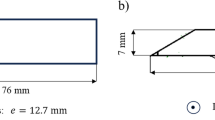Abstract
When machining the parts, an unwanted buildup formation often appears on the working surface of a tool. As a result, dimensions and geometry of the working part of the tool change. The roughness of the machined surface and pulling force increase and unwanted vibrations appear. The work objective was to determine the possibilities of limiting or total elimination of the buildup forming. The research study was carried out using the samples made of alloyed manganese steel grade 15G by GOST 4543 (analogue of AISI 1016) and carbonous quality steel grade 45 by GOST 1050 (analogue of AISI 1045). Hardening was carried out with a smoothing rate of 1 up to 500 mm/s at a pressure in the contact zone from 50 to 1250 MPa and a change in the emerging longitudinal force in the range from 0 to 3 kN. It was found that a deformation rate, contact pressure magnitude, properties of the material being machined, and the lubricant have the greatest influence on buildup forming. The article shows that during steel hardening by smoothing with increasing contact pressure in the tool-part zone, the process of buildup forming occurs according to different mechanisms and appears in three specific zones: in the zone of low contact pressure, where buildup occurs; in the zone of medium contact pressure, where the growth occurs within acceptable limits; in the zone of catastrophic buildup forming.





Similar content being viewed by others
Availability of data and material
The authors confirm that materials supporting the findings of this work are available within the article.
References
Kopp R (1996) Some current development trends in metal-forming technology. J Mater Process Technol 60(1-4):1–9. https://doi.org/10.1016/0924-0136(96)02301-1
Zheng D (Ed) (2015) Industrial Engineering and Manufacturing Technology: Proceedings of the 2014 International Conference on Industrial Engineering and Manufacturing Technology (ICIEMT 2014), July 10-11, 2014, Shanghai, China (1st ed.). CRC Press. https://doi.org/10.1201/b18144
S. V. Fedorov, S. V. Aleshin, M. H. Swe, R. D. Abdirova, A. V. Kapitanov, and S. B. Egorov, “Comprehensive surface treatment of high-speed steel tool,” Mech Ind, vol. 18, no. 7, p. 711, 2017., https://doi.org/10.1051/meca/2017066.
Hakansson H (2015) Industrial technological development. Routledge Revivals. https://doi.org/10.4324/9781315724935
Semenov AB, Fomina ON, Muranov AN, Kutsbakh AA, Semenov BI (2019) The modern market of blank productions in mechanical engineering and the problem of standardization of new materials and technological processes. Adv Mater Technol (1):003–011. https://doi.org/10.17277/amt.2019.01.pp.003-011
A. B. Semenov, A. A. Kutsbakh, A. N. Muranov, and B. I. Semenov, “Metallurgy of thixotropic materials: the experience of organizing the processing of structural materials in engineering Thixo and MIM methods,” IOP Conf Ser Mater Sci Eng, vol. 683, no. 1, p. 012056, 2019., https://doi.org/10.1088/1757-899X/683/1/012056.
Bower AF, Johnson KL (1989) The influence of strain hardening on cumulative plastic deformation in rolling and sliding line contact. J Mech Phys Solids 37(4):471–493. https://doi.org/10.1016/0022-5096(89)90025-2
Yoshimi T, Matsumoto S, Tozaki Y, Yoshida T, Sonobe H, Nishide T (2009) Work hardening and change in contact condition of rolling contact surface with plastic deformation. Tribol Online 4(1):1–5. https://doi.org/10.2474/trol.4.1
S. Fedorov, M. H. Swe, A. Kapitanov, and S. Egorov, “Wear of carbide inserts with complex surface treatment when milling nickel alloy,” Mech Ind, vol. 18, no. 7, p. 710, 2017., https://doi.org/10.1051/meca/2017053.
Kosov MG, Kuznetsov AP, Kapitanov AV, Oleinik AV (2020) Analysis of heat transfer by the response function method. Russ Eng Res 40(1):67–69. https://doi.org/10.3103/S1068798X20010104
Jiang ZY (2011) Mechanics of cold rolling of thin strip. Numerical analysis–theory and application. Intech Open, Rijeka, pp 439–462. https://doi.org/10.5772/23344
Alexandrov IA, Sheptunov SA, Sannikov AS (2019) Some approaches to the formalization principles of achieving the target properties of products in the automation of technological processes in mechanical engineering. 2019 International Conference “Quality Management, Transport and Information Security, Information Technologies” (IT&QM&IS). https://doi.org/10.1109/ITQMIS.2019.8928338
Li Z (2018) Elastic deformation of surface topography under line contact and sliding-rolling conditions. Jixie Gongcheng Xuebao 54(5):142. https://doi.org/10.3901/JME.2018.05.142
Kosov MT, Kapitanov AV (2019) A new finite-element approach to contact problems. Russ Eng Res 39(12):1053–1056. https://doi.org/10.3103/S1068798X19120128
Olejnik A, Kapitanov A, Alexandrov I, Tatarkanov A (2020) Designing a tool for cold knurling of fins. J Appl Eng Sci 18(3):305–312. https://doi.org/10.5937/jaes18-25786
Oleinik A, Kapitanov A, Alexandrov I, Tatarkanov A (2020) Calculation methodology for geometrical characteristics of the forming tool for rib cold rolling. J Appl Eng Sci 18(2):292–300. https://doi.org/10.5937/jaes18-25211
Funding
Some results of this manuscript were obtained as part of the work under the agreement on the provision of subsidies from 14 December 2020 No. 075-11-2020-032 (government contract identifier - 000000S207520RNU0002) on the topic: “Development and organization of high-tech production of valves for the needs of special and medical equipment with high reliability and durability through the application of multicomponent nanocomposite materials” with the Ministry of Science and Higher Education of the Russian Federation.
Author information
Authors and Affiliations
Contributions
Experimentation: Islam A. Alexandrov; writing (original draft preparation): Alexey V. Kapitanov; writing (review and editing): Sergey B. Egorov, Andrej A. Olejnik.
Corresponding author
Ethics declarations
Ethical approval
The article follows the guidelines of the Committee on Publication Ethics (COPE) and involves no studies on human or animal subjects.
Consent to participate
Not applicable. The article involves no studies on humans.
Consent to publish
Not applicable. The article involves no studies on humans.
Competing interests
The authors declare no competing interests.
Additional information
Publisher’s note
Springer Nature remains neutral with regard to jurisdictional claims in published maps and institutional affiliations.
Rights and permissions
About this article
Cite this article
Egorov, S., Olejnik, A., Kapitanov, A. et al. Buildup forming on tools at mechanical metal surface-hardening. Int J Adv Manuf Technol 117, 2237–2242 (2021). https://doi.org/10.1007/s00170-021-07334-6
Received:
Accepted:
Published:
Issue Date:
DOI: https://doi.org/10.1007/s00170-021-07334-6




